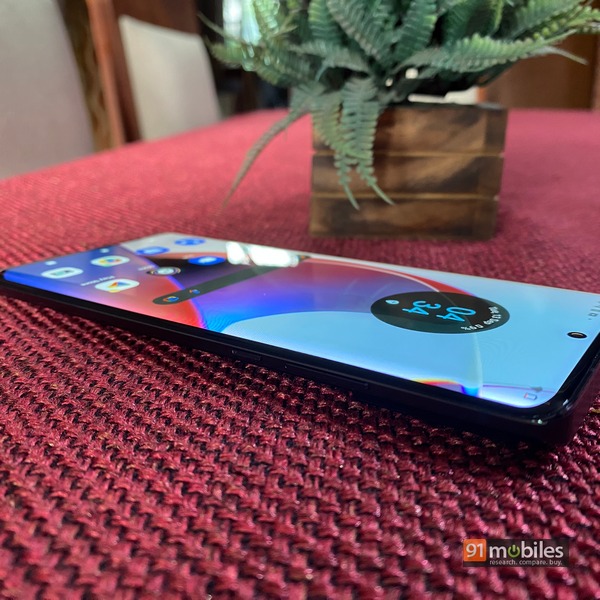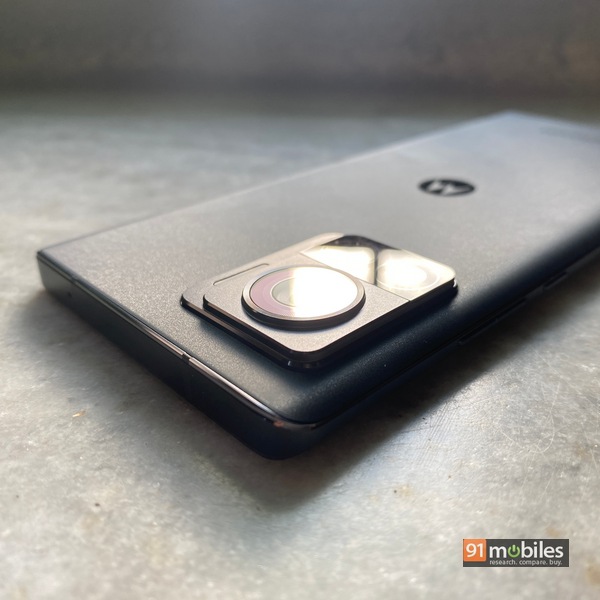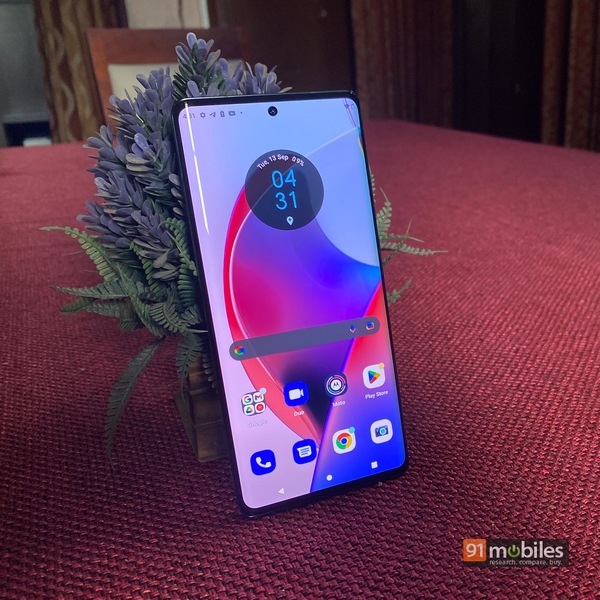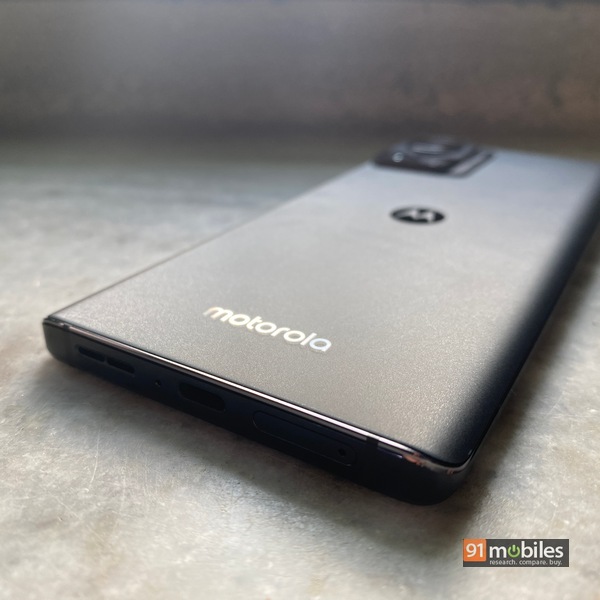Review Summary
Expert Rating
Motorola now competes in almost all price segments in the smartphone space, including the flagship arena. To that end, the Lenovo-owned giant has revealed the Edge 30 Ultra which has the potential to change this very landscape. The specs, on paper, appear to do justice to the smartphone’s Rs 59,999 price tag and the aspect that has caught most people’s attention is the 200MP primary camera. Yes, you read that right. As if 108MP shooters were not enough, Motorola has taken its primary camera’s megapixel count to the next level.

This is the first smartphone in the world to get a sensor with such a high resolution, but the bigger question is whether this upgrade is worthwhile to the end consumer. The Motorola Edge 30 Ultra is an interesting phone with most of its aspects crafted to provide that ultra flagship experience. Let’s find out in this review if the device can stand up to the competition.
Table of Contents
Verdict

Apart from the svelte design and stylish exteriors, the Motorola Edge 30 Ultra also relies on its camera apparatus, performance, and clean software implementation. On the negative side, it comes in only a single 128GB storage variant, has some throttling issues, and needs improvement in low-light photography. The phone does excel in battery life and charging speeds, which make it a worthwhile flagship contender.
Design and display
I consider the Motorola Edge 30 Ultra among the most stylish phones currently in the market. Although I’m not a huge fan of the curved display trend, which many OEMs are opting out of, the undeniable truth is that it does lend a sense of elegance to the device. The Edge 30 Ultra has a narrow aspect ratio and fits comfortably in my hand. Despite the Corning Gorilla Glass 5 finish on the front and back, the device tips the scales at just under 200g while having a thickness of 8.39mm. I like the matte finish on the back panel and the Interstellar Black colour scheme adds to the device’s opulence.

A large portion of the triple-camera housing is reserved for the 200MP Samsung sensor. Below it sits the 50MP ultra-wide and 12MP telephoto sensors that complete the ensemble. Motorola’s branding can be seen in its familiar positioning at the centre while both the volume rocker and power button are present on the right edge. The earpiece slit doubles up to provide stereo sound output with the primary speaker on the bottom. Finally, there is a USB Type-C port, a couple of microphone holes, and a dual-SIM slot on the side that makes up the phone’s design and build.
While there is no stringent water resistance on the device, the company has provided the Edge 30 Ultra with an IP52 rating. Motorola has also been kind enough to pack in a clear silicone case for extra protection while keeping the phone’s elegance on full display. Such is the exquisite nature of its design that only the Samsung Galaxy S22 Ultra (review) or the Vivo X80 Pro (review) can stand toe-to-toe with the Motorola Edge 30 Ultra. However, if there were one thing I could change, it would be a slightly lower positioning of the volume rocker.

Extremely bezel-less in nature, the 6.67-inch Endless Edge display is also a standout feature on the Edge 30 Ultra. The pOLED panel pushes the refresh rate to 144Hz although coming from a 120Hz screen on the OnePlus 10 Pro (review), the difference is not very evident. However, the panel has all the chops to become a stunning visual aid. The screen has HDR10+ capability which works on OTT platforms like Netflix. Apart from that 10-bit panel can display up to a billion colours, and has a peak brightness of 1,250nits along with DC Dimming. Safe to say watching the Rings of Power on the screen was every bit as surreal as the filmmakers wanted it to be.
Motorola has incorporated a few tricks such as Attentive display, Peek display, and Edge lights, for more intuitive usage. There are, however, a few drawbacks which I noticed compared to the competition. The panel is not LTPO 2.0 and can only cycle down to 60Hz to conserve battery. Also, I would’ve liked at least QHD+ resolution at the Edge 30 Pro’s price tag. Despite these omissions though, users looking for a fluid, bright, and colour-rich viewing experience shouldn’t be disappointed.
Cameras
The Moto Edge 30 Ultra is breaking records pertaining to the total amount of megapixel count on its sensors. The 200MP Samsung ISOCELL HP1 sensor handles the primary image-taking responsibilities. There’s also a 50MP Samsung GN5 ultra-wide sensor and 12MP Sony depth shooter that can do 2X telephoto as well. Finally, housed in the punch-hole up top is a 60MP selfie camera. With all these high-resolution sensors, photography can be considered the biggest draw for buyers looking at the Edge 30 Ultra.

Talking about daylight photography capabilities, the primary shooter, with its 1/1.22-inch sensor and 2.56μm pixel size, captures great details. The default shots are 12.5MP images that use ultra pixel-binning to combine 16 pixels into one. You can also opt for 50MP shots as well that make use of quad pixel-binning. Or you can go the full length and shoot in UHD 200MP for that extra bit of clarity.
In my time shooting with the 200MP mode, I gathered that there were very few differences in terms of detail when compared with standard 12.5MP shots. Yes, you can crop into the shot much further with the former and still keep the image crisp. However, a single 200MP shot’s size can range from 50 to 80MB which does limit your internal storage. I also feel that most images you shoot from the device are likely to be viewed on a mobile screen where it won’t matter if your image has a resolution of 200MP or 12.5MP.
Other aspects of the phone’s image-taking prowess are acceptable for flagship standards. Saturation levels of the images are slightly higher than required but the dynamic range and exposure calibration are on point. I do like how Moto interprets most colours although sometimes, depending on the light, the sensor does opt for a more contrasty look. As for focusing, the sensor’s large size allows for a natural bokeh on close-up subjects while also having snappy autofocus. The shutter speeds were slightly slow, and some fast-moving objects like birds appeared out-of-focus in the final shot.


The 50MP ultra-wide sensor is quite good at capturing details, without any sign of the images warping at the edges. In comparison to the primary sensor, the colour temperatures are maintained well although saturation levels are amped up even more. I was quite impressed with the dynamic range available and also how the focus remains sharp across the frame. The 12MP depth camera does a good job at portrait shots and provides a fairly decent 2X telephoto zoom. Inside the camera app, you can choose between different focal lengths depending on where the subject is situated. You can also adjust the bokeh in real time but the effect appears more of a gimmick to me.
Unfortunately, all the great daylight photography aspects do not translate that well into low-light shots. While night images look great on the smaller pOLED screen of the Edge 30 Ultra, on my desktop there was a drop in quality. Now don’t get me wrong… the low-light images can be considered good enough for casual usage, but for the device’s price, I expected more.


My problems were centred around the super bright colours that rob the scenario of its natural look. Exposure levels are not contained and can sometimes overtly brighten up the night sky. This problem becomes more prominent with the dedicated night mode although, on the flip side, it does a very well job of gathering details in the absence of ambient lighting. I think if Motorola adjusted its colour profile and exposure metering in low light via some software update, I would definitely rate it much higher.
Then there is that 60MP selfie camera on the front which also uses quad pixel binning for default shots. The camera is actually quite nice with decent facial tones and a touch of oversharpening. The overall image is pleasant and you can grab a much more detailed picture using the UHD mode, but it is buried inside the camera settings. In terms of video capturing, the Moto Edge 30 Ultra can capture 8K videos at 30fps and also do 4K at 60fps while slow motion maxes out 960fps.
Performance and software
Backed by the Qualcomm Snapdragon 8+ Gen 1 SoC, the Moto Edge 30 Ultra is one of the fastest smartphones in the market. It basically pummels through the usual bunch of benchmarking tests with ease. On Antutut V9.4 the device pops in a 1,047,100 score while Geekbench 5’s multi-core result sits at 4,109. It’s going to come as little surprise that the Edge 30 Ultra is one of the ultimate productivity tools in the Android world when it comes to running heavy apps, multi-tasking, Chrome usage, and more.

However, there are some areas of slight concern, specifically when the smartphone is put under sustained loads. On the CPU Throttle benchmark, the Edge 30 Ultra operates at 69 percent of its peak performance. 3DMark’s Extreme Wild Life Stress test confirms this with a stability score of 67.1 percent. While the phone does not get very hot while running these benchmarks, it appears there is a bit of throttling on the performance to maintain the phone’s temperatures.
Apart from that, you have 8GB of LPDDR5 RAM along with 128GB of UFS 2.1 storage available. I do wish that Motorola could have provided a 256GB variant since the device does not have any external microSD card slot. Finally, any heavy-duty game thrown on the Edge 30 Ultra worked effectively. I myself tested out some BGMI and it ran at HDR graphics with Extreme (60fps) frame rate without a hitch.

The Edge 30 Ultra has a set of stereo speakers that are Dolby Atmos tuned and sound wonderful. Authentication is done via an in-display fingerprint sensor of the optical variety. Both the registration and unlock processes are swift although the facial unlock could use some more fine-tuning. In line with all flagship phones, the Edge 30 Ultra also has 5G capabilities and supports 13 bands that should become available for use in the coming months. For now, the device’s 4G LTE network speeds were more than satisfactory on Noida’s Jio network.
For software needs, Motorola’s MyUX skin is running on the device and it is basically stock Android with some sprinkling of Moto apps. These include the Motorola customisation app which lets you customise layouts, fonts, gestures, display features, and more.

You also get a Ready For app which is effectively like Samsung’s DeX but with a few extra steps. With this, you can pretty much get a desktop-like experience when connected to an external monitor via a USB Type-C cable. It also works wirelessly on your PC but you need the Read For app installed on the PC. Apart from that MyUX is as clean and user-friendly as it can get. Currently, the device is on Android 12 but Motorola has promised updates up to Android 15 along with four years of security patches.
Battery
There is a 4,600mAh cell present on the Moto Edge 30 Ultra, backed up by a 120W fast charger provided in the box. The Qualcomm Snapdragon 8+ Gen 1 has been known to be power efficient and combined with Motorola’s rather clean software, the battery life on the device won’t be a problem. I ended up using the phone for about a day and a half without once thinking about juicing the battery up.

This included running two 30-minute throttling benchmarks, at least an hour of gaming, two episodes of Rings of Power, and some casual social media usage. On average, I’m getting upwards of seven hours in the way of screen-on time. The super fast 120W charging can fill up the battery from 0-100 percent in about 26 minutes, which is a very handy feature. Also, any Qi-compliant charger can juice up the cell wirelessly at 50W and the device itself offers reverse wireless charging speeds of 10W.
Final verdict
The Moto Edge 30 Ultra can be availed for Rs 54,999 as part of a limited-time offer. I feel that is perhaps the best pricepoint on the device to compete with the likes of the OnePlus 10T and the Vivo X80. The original price tag of Rs 59,999 is a slightly harder sell when you are only offering 128GB of storage and 8GB of RAM. However, you do get some excellent features such as a 144Hz pOLED screen, 120W charging, and the ability to take 200MP images.

I have to say that the performance levels are up to the mark on the device and the clean software makes it even better. My only concerns revolve around some throttling seen under sustained loads and overexposure in low-light photos. All things considered, the Motorola Edge 30 Ultra is a fantastic phone that combines a refined look with competent hardware.
Editor’s rating: 3.5 / 5
Pros:
- Stylish design
- Clean, user-friendly software
- Nice daylight photography
- Decent battery life
Cons:
- Can throttle under sustained loads
- Low light photography can be improved
- Only a single 128GB storage option
 Motorola Edge 30 Ultra 5G Motorola Edge 30 Ultra 5G | vs |  OnePlus 10T OnePlus 10T |
 Motorola Edge 30 Ultra 5G Motorola Edge 30 Ultra 5G | vs |  iQOO 9T 5G iQOO 9T 5G |


































![[Exclusive] Motorola Rogue (Edge 30 Ultra) render shows off new gradient colour option Thumbnail](https://www.91-cdn.com/hub/wp-content/uploads/2021/11/moto-rogue-render-image-feat.jpg?tr=h-110,q-100,pr-true)
![[Exclusive] Motorola Edge 30 Ultra/Edge X 5K renders and specifications revealed Thumbnail](https://www.91-cdn.com/hub/wp-content/uploads/2021/11/Motorola-Edge-X.jpg?tr=h-110,q-100,pr-true)

